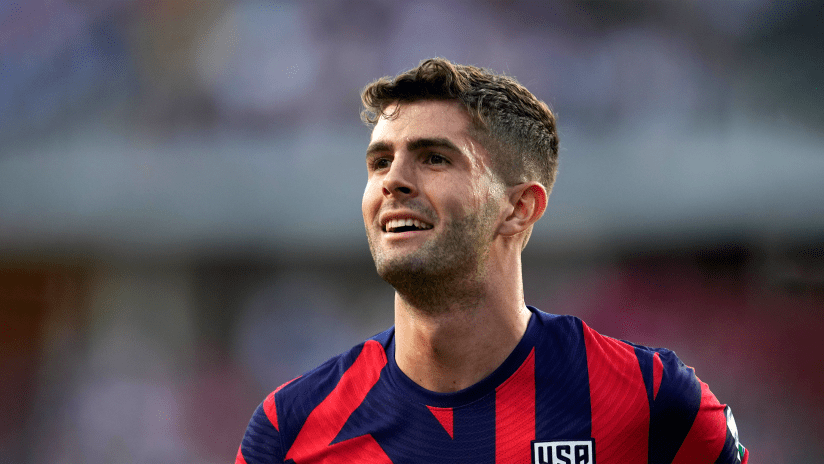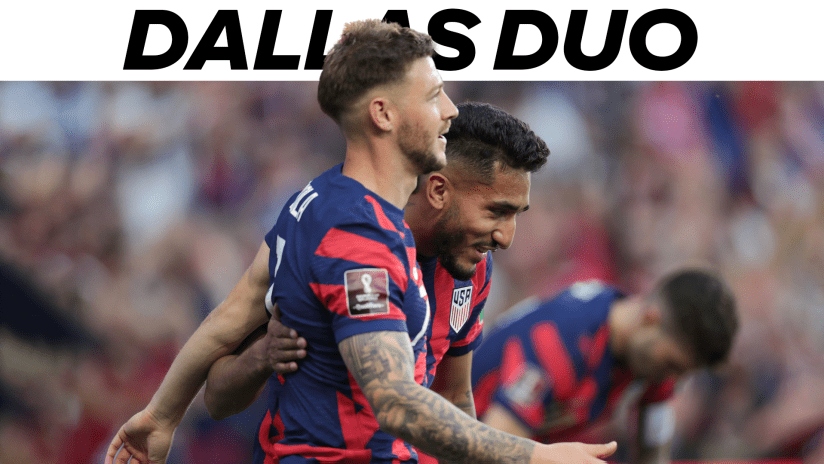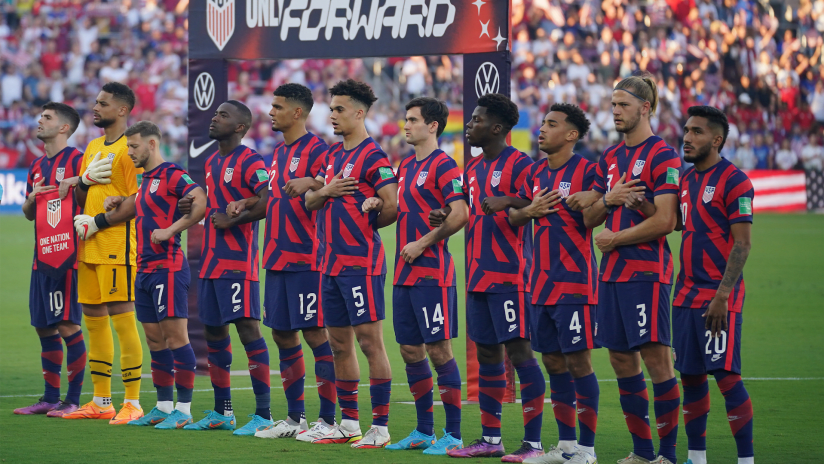About 99% of the time, these columns of mine are about tactics. How Team A set up in order to break down Team B, and the adjustments Team B made to turn it back on Team A, is always the most fascinating part of the game to me. It’s often the part that matters most in terms of the outcome as well.
But it’s not always that way. And in fact, it’s not even mostly that way. The dirty secret is that whichever team comes out with more intensity and more ability to execute in big moments is often the explanation for who wins and who loses. You need to have your tactics and strategy right, but, to borrow a line from Real Salt Lake head coach Pablo Mastroeni: "All the soccer stuff aside, if you don’t have the right character and mentality, then [you don’t] have the chance. It’s a game that is unforgiving, and you have to earn the right in these games."
Such has been the story of World Cup qualifying thus far for the US men’s national team. I’m not going to say they haven’t earned the right, because they absolutely have – they are super-talented and, defensively and in possession, the tactics have been very good. But overall intensity and a lack of clear-eyed ruthlessness in big moments have been issues.
There are two great examples of this that come to mind:
1. The 2-0 loss at Canada back in January. In the fourth minute, Canadian goalkeeper Milan Borjan shanked a goal-kick right up the gut, directly to Weston McKennie about 40 yards from goal. It was an immediate five-alarm fire for the Canadian defense, but McKennie couldn’t get his touch right and it turned into a whole lotta nothing.
Three minutes later Matt Turner did the same exact thing, and we all remember what happened, right? Kamal Miller got his touch right, and then Jonathan Osorio absolutely got his touch right, and a moment later Cyle Larin was making it 1-0.
The Canadians executed in a big moment. The US couldn’t quite manage it. That was the story of that game.
2. The US’s 1-0 loss at Panama back in October. That was easily the worst performance of qualifying, and maybe the worst performance under head coach Gregg Berhalter, full stop. There were tactical issues for sure (Berhalter talked about a bunch of them on the US Soccer Podcast with Bobby Warshaw), based around the positioning of the fullbacks and rotations in central midfield.
But I’d argue the outcome of that game had more to do with Los Canaleros hitting a level of intensity the US were not able to reach than it did with any tactical choices Berhalter made, or that the team did not execute. Panama simply fought for it more, and because of that, they won it.
The US hadn’t had any performances like that in qualifying, games where they just beat their opponents over the head with sheer force of will. The intensity level has waxed and waned more, I’d argue, than any other team in the Ocho, which is likely due to the nature of the still-extremely-young roster. And even when they cranked that intensity meter up to 11 for the two games against Mexico – the only two games, until Sunday night, in which they’d hit that mark – they were either paired with a tactical masterclass (the 2-0 win in November) or an inability to execute in the biggest moments (Thursday’s scoreless draw).
Then Sunday night happened. The US’s 5-1 win over Panama in Orlando, a result that all but assures them of a direct trip to Qatar*, was not a tactical masterclass. The US came out and played their typical 4-3-3 formation with no bells and whistles, and given the dead legs seven of the starters were carrying from the hard minutes at the Azteca, there were a lot of sloppy touches. There were a lot of slow overlaps, and there was a final tally that said the US carried less than 40% possession. This was not the typical Berhalter game plan.
(*) Yeah, I said it.
But once the US survived the first 10 minutes – and they really did seem to be just holding on for dear life – they were suddenly looking Panama in the eye and giving as good as they got. My colleague Michael Lahoud, on our watchalong, put it this way: “In these games, you’ve got to meet these teams where they’re at. Show them that you’ll beat them in a fight, and then show them that you’ll beat them at soccer.”
And that’s how it played out. This game had beautiful moments for the US, but it was not a beautiful game of soccer overall. Sometimes you have to win like that, though, and that’s been the toughest lesson for this group to learn in qualifying.
“When I look at the effort and intensity of the first half and the level that we were playing at, it was really impressive,” Berhalter said afterward. “You can see exactly what the guys took on, and their motivation to get back to the World Cup.”
The mentality was good. The kids have grown up on this journey through Concacaf, and they have earned the right to go to Qatar.
• Walker Zimmerman’s clearly one of the very first names on the team sheet, to the point of maybe being the US’s most valuable player throughout qualifying. He showed it again on Sunday when he had the wherewithal to prevent the US from taking a quick throw-in after he’d been brought down in the box, giving the officiating crew time to go to Video Review for the previous corner kick:
That is just excellent recognition of the moment and is a sequence that changed the game.
• The US then used the decoy penalty taker scheme on the ensuing PK. Jesus Ferreira stood at the spot with the ball under his arm like he was going to take the spot kick, and was subjected to the typical abuse and trash talk that comes from opponents in that situation. The US’s actual penalty taker, Christian Pulisic, got to chill at the top of the box, being hounded by no one as he got his head right and prepared to take the PK.
The first time I’d noticed any team do this was at the Club World Cup final when Chelsea sent Cesar Azpilicueta to the spot to take abuse from Palmeiras (including our guy Eduard Atuesta, who fell hard for it) while Kai Havertz got to chill a bit:
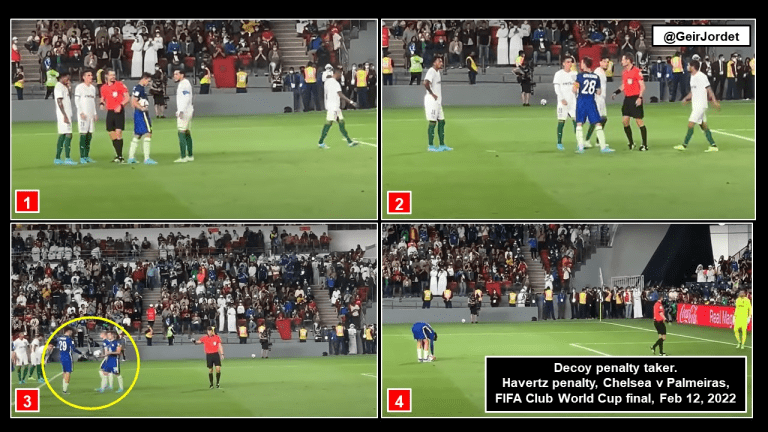
Little things matter. Though I do find it amusing as hell the US also did this on the second penalty of the night. The Panamanians were less fooled by that one.
• The US wingers, Pulisic and Paul Arriola, did such a good job of getting narrow early and giving Ferreira teammates to play off of in possession. One of the dangers with the 4-3-3 is that the striker can become stranded on an island, but even when the US were struggling to build a bit in this one, that was never the case.
• Pulisic stretched the field off the ball more in this game than he’s done at any point in qualifying, I think. It was particularly effective during the build-up to the second goal, Arriola’s neat header from just outside the six-yard box.
Arriola is so clever at that type of danger-creating movement. It was nice to see him finish one off and get on the scoreboard.
• It is probably not surprising the prettiest sequence of play on the night came largely through the four starters – Arriola, Ferreira, Luca de la Torre and Shaq Moore – who didn’t play at Mexico, and thus had fresh legs for this one:
I don’t think we can give them credit for a 15-pass buildup to Ferreira’s finish because I’m pretty sure that penultimate touch was a deflected shot from Arriola, not a pass, but still: when you string that many passes together 25 yards from goal and in, and you move that well on and off the ball, you are doing a bunch of things right.
• Pulisic’s third goal will have a featured spot on every career highlight compilation thrown up on YouTube for the next two decades. That is just the pure essence of execution in a big moment.
• Zack Steffen was about the only US player who truly struggled, following up an assured performance at Mexico on Thursday with a scattered one in which he flapped at crosses and couldn’t manage to hold onto the ball a few times. He got particularly lucky in the moments after the US had taken a 1-0 lead not to concede a soft one.
• De la Torre has taken his opportunity with both hands, and is pretty easily the third No. 8 behind McKennie and Yunus Musah.
The US have technically made it to Qatar. Now, whether that means for the World Cup proper, or for a single-elimination qualifier against Oceania’s representative – either New Zealand or the Solomon Islands – to be held in Qatar in June remains to be seen.
As it stands, the US occupy second place in the Ocho, tied with Mexico on points (25) but with a far superior, +13 goal differential. The Ticos are in fourth place on 22 points with a +3 goal differential. A win, a draw, or a loss by fewer than six goals gets the US one of the three auto-qualifying spots, and most likely sends Costa Rica to the playoff (as poor as Mexico’s been, I don’t think they’re going to lose to El Salvador at home).
Here's how the standings look:
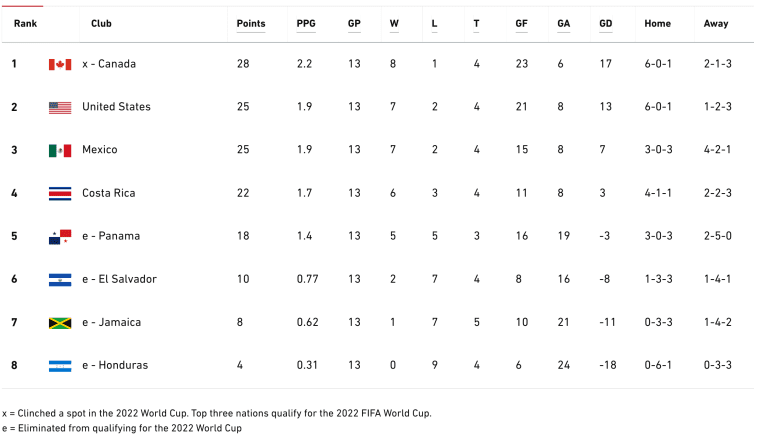
That’s about it for the math. I don’t think any extra bells and whistles are necessary. Berhalter just needs to continue to rotate and use his subs liberally, and get the guys he puts on the field mentally prepared to do the job.
“I was in this exact position or very similar position four years ago, and we know how that qualification ended,” Arriola said, referring to the US’s four-goal win over this same Panama side in Orlando, just before 2017's disaster at Trinidad & Tobago. “It’s just maintaining focus, understanding we still have work to do, and anything is possible. The mentality of this group is and has to be to go down there and get a good result against Costa Rica.”
They need, once again, to play for a win. The US’s defensive structure has been better when they play like that than when they bring on extra defenders to put numbers behind the ball, as we saw in the final 10 minutes at the Azteca last Thursday night.
None of that 5-4-1 stuff, please.

• Pulisic and Tyler Adams get a rest. I don’t think either will particularly like that, but both have been injury-prone over the course of their respective careers, so let’s hope sweet reason wins out, and that they’ll be happy as 35-minute super-subs in this one.
The same, obviously, goes for Gio Reyna.
• I wanted to change Antonee Robinson out, but I just can’t quite get there with George Bello, who has been poor for the US in previous qualifiers and has been the same since his move from Atlanta United to Arminia Bielefeld.
Hopefully the game’s circumstances mean a halftime sub is appropriate.
• Aaron Long gives Zimmerman a rest, with the understanding Zimmerman – or maybe Erik Palmer-Brown – comes in at the hour mark for Miles Robinson.
• Ferreira, for me, has earned another start at center forward.
• I’d like to see Ethan Horvath get 90 minutes in this one. Given how injury-prone Steffen’s been and Turner’s mystery foot ailment, getting the third-string GK a run-out actually makes a lot of sense.
• Bear in mind the Ticos have a bunch of players on yellow cards, and the assumption is that a yellow picked up in this game would lead to a suspension for yellow card accumulation for the playoff. I’m not 100% sure that is correct – I couldn’t find it spelled out anywhere – but it doesn’t strike me as an unfounded assumption.
Regardless, the Costa Ricans will be playing to win. They always do down in San Jose, and the US, of course, have lost by multiple goals in every qualifier down there this century.
Now’s the chance to change that. Go down and meet the Ticos where they’re at. Beat them in the fight, then beat them at the game. And finally, officially, qualify for the World Cup.

